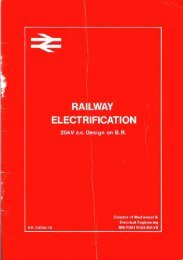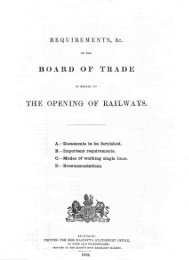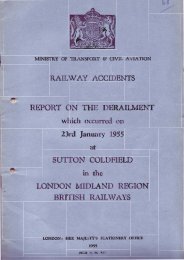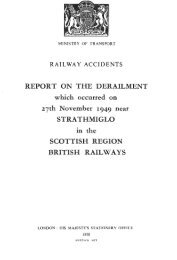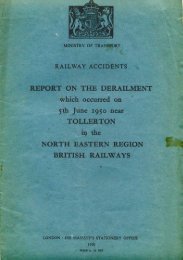R A I LT R AC K - The Railways Archive
R A I LT R AC K - The Railways Archive
R A I LT R AC K - The Railways Archive
Create successful ePaper yourself
Turn your PDF publications into a flip-book with our unique Google optimized e-Paper software.
What the plans deliver<br />
<strong>The</strong> major deliverable from these plans is the capacity to accommodate a 30% growth in passenger kilometres and a 200%<br />
growth in freight volumes over ten years.<br />
<strong>The</strong> effect of our plans will be to produce a range of other improvements to the capacity and capability of the network.<br />
In addition to the targets we have set for improvements to delays per train movement of 7.5% and 5% respectively for the<br />
next two years (1999/2000 and 2000/01) our renewal plans involve further annual reductions averaging 2.5% over the next<br />
Control Period.By 2005/06,the cumulative reductions in delays per train movement attributable to Railtrack will have reached<br />
nearly 60% against 1995/96 levels. We are also currently evaluating the cost implications of an alternative option of achieving<br />
5% annual performance improvements post 2001 which we shall be discussing with the Franchising Director.<br />
Following commitments made to the Rail Regulator, we have started to implement a track-quality improvement<br />
programme which, by April 2001,should deliver the highest levels of track quality ever recorded.<br />
Our plans will also produce improvements in journey times, improved station facilities on a range of dimensions,and<br />
an increased freight loading gauge for a proportion of the network,to enable large containers to be carried.<br />
<strong>The</strong> funding challenge – financing the rail renaissance<br />
This £27bn programme is the largest upgrade of infrastructure since the railways were first built. Delivery of a programme<br />
of this scale involves a massive challenge which can only be met through an effective partnership between the public and<br />
private sectors.<br />
Railtrack is already committed to funding much of this investment through its own borrowing.Our previous programme<br />
of £17bn will already lead to us being one of Britain’s biggest borrowers with an expected debt of around £4bn by 2003/04.<br />
<strong>The</strong> additional financing required to fund this investment can only be sustained if Railtrack and other interested parties have<br />
the right financial framework which provides an appropriate return on investment – both debt and equity.<br />
<strong>The</strong> Rail Regulator is currently reviewing our financial framework as part of his periodic review of access charges. In<br />
December, he published his initial conclusions on the financial framework, following the broad approach adopted for other<br />
utilities,such as water. But as a low-risk/low-return‘contractor’and with a regulatory asset base defined in terms of the original,<br />
heavily discounted, flotation value , our future revenues would be reduced and our funding capacity would be significantly<br />
curtailed.<br />
Our current rate of renewal spend (£1.4bn annually) is double the level three years ago and by 2001 we shall have<br />
spent £1.25bn more than the Rail Regulator allowed on renewals when the current level of access charges was set in 1994<br />
– although he has so far been unwilling to allow a return on this additional spend.<strong>The</strong> tight financial framework outlined in<br />
the Rail Regulator’s December document will not enable the proposed programme to be delivered.<br />
However, the Regulator indicated a way out of this dilemma.This was for us to grow our business through commercial<br />
partnerships with customers and Government, taking additional risk but securing additional rewards.That is what we have<br />
sought to do through this NMS.<br />
With accelerated or new investment being one of the Government’s published criteria for franchise renegotiation, we<br />
anticipate working with train operators to assist them in this process.<br />
Delivery of these plans provides a challenge to Railtrack, the Rail Regulator, the Strategic Rail Authority and to the<br />
Government to develop the right financial framework and balance of risk between the public and private sectors. Rail<br />
investment has the potential to produce benefits which go much wider than the industry and ultimately affect the quality of<br />
life in this country. For this reason,it requires a true public–private partnership.<br />
<strong>The</strong> Rail Regulator<br />
indicated a way out<br />
of this dilemma... to<br />
grow our business<br />
through commercial<br />
partnerships with<br />
customers and<br />
Government<br />
9



